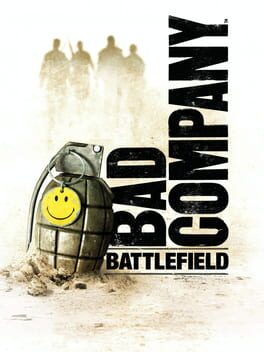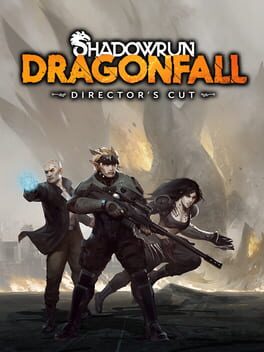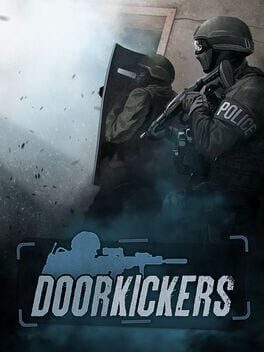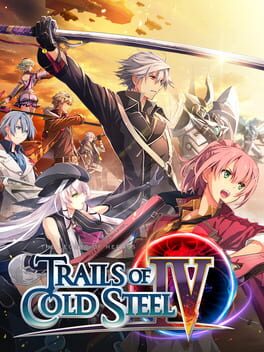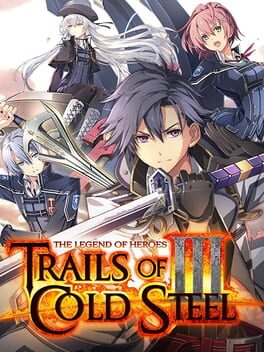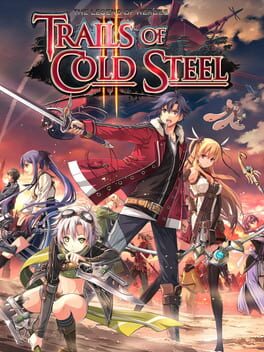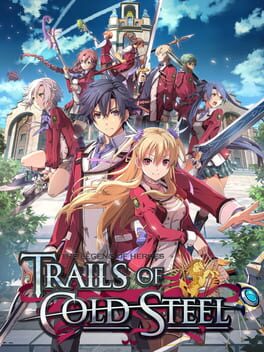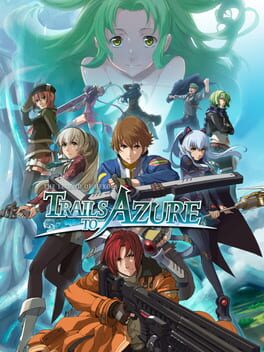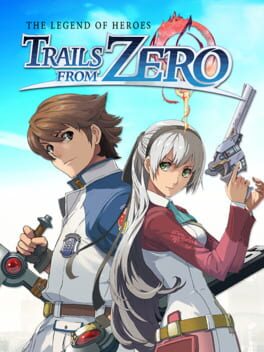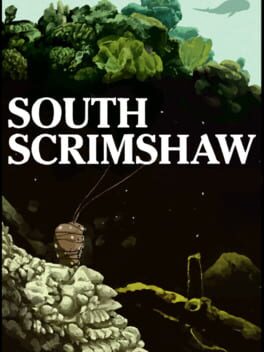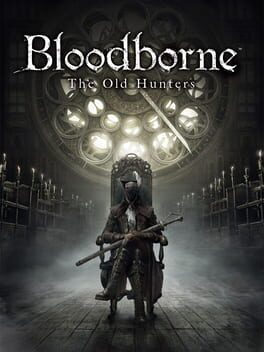funsohng
So this is the beginning of Battlefield's "large open level design for the sake of open design and not much else." Control scheme is weird, especially with vehicle controls (L2 for reverse and L1 for acceleration? Who thought of this??), the much-marketed destructible environments are honestly not that useful in the actual game, compared to later games in the series.
Also, who thought it was good idea to not have subtitles???
Also, who thought it was good idea to not have subtitles???
Shadowrun Returns was a very competent taste of the very potent Shadowrun universe, but Dragonfall is something else, at least when it comes to story. It's on the shorter side (even if it's considerably longer than the original), but considering the focuse on a single team of shadowrunners, it makes sense.
It's the narrative that really shines here--the main story has gripping pace especially towards the latter half, constantly throwing scenarios that are inspired by existing cyberpunk tropes, but with unique twists that only Shadowrun can offer. There is nothing like this, and the writing is absolutely top-tier to make the best of it. There are no voice work in this game, sadly, but the dialogues are written so vividly that it's not hard to imagine the voices. Each team member is given a great care in building their personality through their dialogues, and dialogue options to talk out of sticky situations never feel tacked on and provide organic narrative flow.
I just don't like the combat though, which was the same case with the predecessor. It's X-COM, but with a lot of moving parts with RPG mechanics, magic, hacking, summons, etc. and they are tutorialized very, very poorly. There is that inherent divisive mechanic of "you will miss A LOT" but the way to compensate that disadvantage is buried deep in the pile of smaller mechanics that the game does not do a good job (or any job, for that matter) introducing to the players. The hacking portion being a blend copy and paste of the main combat system, just in a different environment, also doesn't help.
If you really want to just engage with the story, which I highly recommend, the debug menu is easy to access.
It's the narrative that really shines here--the main story has gripping pace especially towards the latter half, constantly throwing scenarios that are inspired by existing cyberpunk tropes, but with unique twists that only Shadowrun can offer. There is nothing like this, and the writing is absolutely top-tier to make the best of it. There are no voice work in this game, sadly, but the dialogues are written so vividly that it's not hard to imagine the voices. Each team member is given a great care in building their personality through their dialogues, and dialogue options to talk out of sticky situations never feel tacked on and provide organic narrative flow.
I just don't like the combat though, which was the same case with the predecessor. It's X-COM, but with a lot of moving parts with RPG mechanics, magic, hacking, summons, etc. and they are tutorialized very, very poorly. There is that inherent divisive mechanic of "you will miss A LOT" but the way to compensate that disadvantage is buried deep in the pile of smaller mechanics that the game does not do a good job (or any job, for that matter) introducing to the players. The hacking portion being a blend copy and paste of the main combat system, just in a different environment, also doesn't help.
If you really want to just engage with the story, which I highly recommend, the debug menu is easy to access.
2023
It starts with a very bad taste in mouth. Being a follow-up to the very divisive Cold Steel 4 doesn't help, but the fact its beginning is repeating the same narrative beats done in Azure and Cold Steel regarding Crossbell only amounts to exhaustion. And in terms of Lloyd's route, it never really changes, with some moments deliberately placed as a call back to the predecessors--Lloyd is facing the same problem yet again, and since there is nothing more to add to his development, his story ends up feeling redundant.
While Lloyd's route does end up taking the most time out of three, it thankfully isn't an overhwelming ratio compared to the other two. Rean's route is supplementary as one would expect, and his character arc is also disappointingly a retread, but due to how closely it relates to the final route with all new characters, it's more bearable.
And that final route is indeed a breath of much needed fresh air. The core 4 characters are as balanced in their chemistry as the S.S.S. in Zero, and the guests that join them as the game goes on provide interesting perspectives on them as well. These three routes all interact at some point with each other, like how dungeons with multiple teams in CS3 and CS4 worked, and even though there is not much freedom as to what you can do and you are more or less expected to play in a linear way, the way they interconnect still provides interesting storytelling opportunities that the series desperately needed. And the ending, while it's based on the similar deus ex machina cliche that made Cold Steel 4 difficult to like, ties up everything in a way more satisfying than that game ever could have hoped to.
A significant bulk of the game, however, is pushed aside to the Reverie Corridor, a dungeon that exists in a dimension separate from Zemuria. It acts as a convenient place for the game to include a plethora of side activities, with minigames (both VM and Pom Party make their return with the largest opponent roster ever in the series) and side episodes that shows glimpse of other stories not directly related to the main story of the game. Some of these sheds more light on some supporting cast member such as Ash and Kurt, while others set up some world-altering revelations for the next arc in the franchise. They are in essence like Trails in the Sky The 3rd, but with the dungeon crawling aspect more streamlined and with dynamic map layout and missions; having the main story that occurs separately in the real world Zemuria also makes it more relevant in the grand scheme of things.
Overall, a fitting conclusion to both the Ereborian and Crossbell saga, allowing the fans of the series to be more hopeful for the future instead of how Cold Steel 4 had left them.
While Lloyd's route does end up taking the most time out of three, it thankfully isn't an overhwelming ratio compared to the other two. Rean's route is supplementary as one would expect, and his character arc is also disappointingly a retread, but due to how closely it relates to the final route with all new characters, it's more bearable.
And that final route is indeed a breath of much needed fresh air. The core 4 characters are as balanced in their chemistry as the S.S.S. in Zero, and the guests that join them as the game goes on provide interesting perspectives on them as well. These three routes all interact at some point with each other, like how dungeons with multiple teams in CS3 and CS4 worked, and even though there is not much freedom as to what you can do and you are more or less expected to play in a linear way, the way they interconnect still provides interesting storytelling opportunities that the series desperately needed. And the ending, while it's based on the similar deus ex machina cliche that made Cold Steel 4 difficult to like, ties up everything in a way more satisfying than that game ever could have hoped to.
A significant bulk of the game, however, is pushed aside to the Reverie Corridor, a dungeon that exists in a dimension separate from Zemuria. It acts as a convenient place for the game to include a plethora of side activities, with minigames (both VM and Pom Party make their return with the largest opponent roster ever in the series) and side episodes that shows glimpse of other stories not directly related to the main story of the game. Some of these sheds more light on some supporting cast member such as Ash and Kurt, while others set up some world-altering revelations for the next arc in the franchise. They are in essence like Trails in the Sky The 3rd, but with the dungeon crawling aspect more streamlined and with dynamic map layout and missions; having the main story that occurs separately in the real world Zemuria also makes it more relevant in the grand scheme of things.
Overall, a fitting conclusion to both the Ereborian and Crossbell saga, allowing the fans of the series to be more hopeful for the future instead of how Cold Steel 4 had left them.
2014
A really cool proof of concept, and the basic gameplay loop is thoroughly enjoyable.
However, the difficulty and progression ultimately made me quit prematurely. The game is brutal, and honestly, that's alright. But the problem is, the progression system compounds to that difficulty unnecessarily. In this game, the progression is universal, meaning that skirmishes and campaigns share the progression. There are three types of progression, the squad level, the roster stars (currency) and doctrine points (skill tree). You obtain all of these from doing skirmishes, randomly generated maps and campaigns to level up your squad level. The problem is that too many features are locked behind these universal progressions--you don't have access to shotguns until squad level 12, you don't have access to assault rifles until you use the roster stars, and your squad doesn't have their full potential unlocked until you have enough points invested in the skill tree. This means that early game is frustratingly hard for no reason at all. Imagine Starcraft, but until you hit certain rank, you can't pick Protoss or you can't produce Ghosts as Terran until you unlock them in the main menu with a currency you have to grind by playing the game.
There is no overarching tutorial system that goes over and naturally unlock these either (you can't even play campaign until you are squad level 6), meaning that early game is just you doing random skirmishes with no real guidance whatsoever. And when you do unlock the campaign, sometimes you just don't have the right equipment unlocked to beat the map optimally (i.e. you don't have access to proper stealth option at the beginning). The squadmates are also perma-death in the campaign (each squad member also have light progression system where they get promotions and their stats grow), but not in the skirmish, which again creates a weird discrepancy. This feels like an unnecessary padding, and a poor way to guide to newcomers to the game.
There is also problem of covers being extremely simplified; you can't lean from the walls, and for some reason, a hood of a car is considered a full cover so you can't attack from it either. The pathing control is sometimes a bit janky as well, though it wasn't too much of a concern/could've been my own fault. Then there is a minor gripe of the guns themselves not being customizable through gunsmith, which isn't a downside, but would've added an interesting depth.
Then again, the core gameplay loop is very much solid, and the concept is good enough that I will most likely try the sequel, which seems to be more improved and accessible than the original.
However, the difficulty and progression ultimately made me quit prematurely. The game is brutal, and honestly, that's alright. But the problem is, the progression system compounds to that difficulty unnecessarily. In this game, the progression is universal, meaning that skirmishes and campaigns share the progression. There are three types of progression, the squad level, the roster stars (currency) and doctrine points (skill tree). You obtain all of these from doing skirmishes, randomly generated maps and campaigns to level up your squad level. The problem is that too many features are locked behind these universal progressions--you don't have access to shotguns until squad level 12, you don't have access to assault rifles until you use the roster stars, and your squad doesn't have their full potential unlocked until you have enough points invested in the skill tree. This means that early game is frustratingly hard for no reason at all. Imagine Starcraft, but until you hit certain rank, you can't pick Protoss or you can't produce Ghosts as Terran until you unlock them in the main menu with a currency you have to grind by playing the game.
There is no overarching tutorial system that goes over and naturally unlock these either (you can't even play campaign until you are squad level 6), meaning that early game is just you doing random skirmishes with no real guidance whatsoever. And when you do unlock the campaign, sometimes you just don't have the right equipment unlocked to beat the map optimally (i.e. you don't have access to proper stealth option at the beginning). The squadmates are also perma-death in the campaign (each squad member also have light progression system where they get promotions and their stats grow), but not in the skirmish, which again creates a weird discrepancy. This feels like an unnecessary padding, and a poor way to guide to newcomers to the game.
There is also problem of covers being extremely simplified; you can't lean from the walls, and for some reason, a hood of a car is considered a full cover so you can't attack from it either. The pathing control is sometimes a bit janky as well, though it wasn't too much of a concern/could've been my own fault. Then there is a minor gripe of the guns themselves not being customizable through gunsmith, which isn't a downside, but would've added an interesting depth.
Then again, the core gameplay loop is very much solid, and the concept is good enough that I will most likely try the sequel, which seems to be more improved and accessible than the original.
Erebonians: "People can't be this mean and hostile to each other, there must be some mysterious dark force at work here!"
Me, educated in European History: "Mate, you are Germans, and this is called Prussian Militarism."
Utterly braindead and painfully convoluted contrivances bombards the entire plot, but fuck it, I can't deny the highs are so fucking high.
Me, educated in European History: "Mate, you are Germans, and this is called Prussian Militarism."
Utterly braindead and painfully convoluted contrivances bombards the entire plot, but fuck it, I can't deny the highs are so fucking high.
Overall, a step up from both predecessors.
Rean as a teacher fits his character much more. Before, he was a bland, boring Light Novel Protagonist #513412; now, his almost annoying "nice guy" attitude that takes on too much himself makes sense, as a person responsible for his own class of students. The smaller main cast also helps to flesh out the chemistry between the newcomers, especially compared to old Class VII cast. The balance is almost as good as the S.S.S., which is probably the golden standard when it comes to party chemistry in JRPGs.
The combat is perhaps even less balanced, but weirdly more satisfying. The new break system and seamless battle transitions make the combat a breeze, especially compared to the first two Cold Steel games, which was becoming almost unbearable by the end of the overlong epilogue(s) of CS2. Crafts are still overpowered--even with nerfs to the CP consumption--but they have always been the best way to increase the tempo of the combat in the series anyway.
The world-building still shines--for the most part. The small details they lay out are still great to discover, and with the largest cast of returning characters thus far, it's an absolute treat to see (slightly) grown-up versions of the characters from previous games doing (slightly) grown-up things. However, the series staple of frustrating storytelling tendencies continues at full throttle, cockteasing twists and reveals for 80 hours of playtime to the point it's honestly now just exhausting.
Then there are villains. CS4 exists so I can't really comment much here, but what is revealed here is disappointing. The supposed goal of Osbourne as revealed here (unless they pull the rug underneath again in CS4) is far too bland, especially compared to the meticulous world-building the series has constructed thus far. No villain is really "likable," or even "admirable," and they are written as if the writers were trying to annoy the players as much as possible, without much substance. I don't really want to know about these villains anymore, I just want them gone at this point.
Also fuck that ending. Fuck you, Falcom.
Rean as a teacher fits his character much more. Before, he was a bland, boring Light Novel Protagonist #513412; now, his almost annoying "nice guy" attitude that takes on too much himself makes sense, as a person responsible for his own class of students. The smaller main cast also helps to flesh out the chemistry between the newcomers, especially compared to old Class VII cast. The balance is almost as good as the S.S.S., which is probably the golden standard when it comes to party chemistry in JRPGs.
The combat is perhaps even less balanced, but weirdly more satisfying. The new break system and seamless battle transitions make the combat a breeze, especially compared to the first two Cold Steel games, which was becoming almost unbearable by the end of the overlong epilogue(s) of CS2. Crafts are still overpowered--even with nerfs to the CP consumption--but they have always been the best way to increase the tempo of the combat in the series anyway.
The world-building still shines--for the most part. The small details they lay out are still great to discover, and with the largest cast of returning characters thus far, it's an absolute treat to see (slightly) grown-up versions of the characters from previous games doing (slightly) grown-up things. However, the series staple of frustrating storytelling tendencies continues at full throttle, cockteasing twists and reveals for 80 hours of playtime to the point it's honestly now just exhausting.
Then there are villains. CS4 exists so I can't really comment much here, but what is revealed here is disappointing. The supposed goal of Osbourne as revealed here (unless they pull the rug underneath again in CS4) is far too bland, especially compared to the meticulous world-building the series has constructed thus far. No villain is really "likable," or even "admirable," and they are written as if the writers were trying to annoy the players as much as possible, without much substance. I don't really want to know about these villains anymore, I just want them gone at this point.
Also fuck that ending. Fuck you, Falcom.
2020
On one hand, Pikmin 3's core exploration-based puzzle designs are top-notch. With how each levels are laid out and the opening up of more abilities as you unlock more pikmins, these levels feel like a smaller metroidvania levels, encouraging the players to return, so they can find all the collectibles they missed on their first foray.
On the other hand, the game has its share of frustrations. The controls are not really easy to get used to, especially aiming, with how finicky the reset gyro works. The game is also designed for multitasking, but because of the nature of the console it's on, it's simply not intuitive enough--often I was left feeling I was being limited by the game instead of my own shortcomings. Not being able to order around companions on the map unless the player is specifically controlling that member is annoying, but with the fact the player cannot easily divide pikmins into teams, some of these limitations are actively working against the game's core objective. The ever-present stress of daily time limit also become more annoying than acting as a hurdle to encourage efficiency.
It's a terrific game. Some of the joys you get from playing this is quite unparalleled, especially with how unique the concept is. But I can't lie that I was secretly glad it was short.
On the other hand, the game has its share of frustrations. The controls are not really easy to get used to, especially aiming, with how finicky the reset gyro works. The game is also designed for multitasking, but because of the nature of the console it's on, it's simply not intuitive enough--often I was left feeling I was being limited by the game instead of my own shortcomings. Not being able to order around companions on the map unless the player is specifically controlling that member is annoying, but with the fact the player cannot easily divide pikmins into teams, some of these limitations are actively working against the game's core objective. The ever-present stress of daily time limit also become more annoying than acting as a hurdle to encourage efficiency.
It's a terrific game. Some of the joys you get from playing this is quite unparalleled, especially with how unique the concept is. But I can't lie that I was secretly glad it was short.
Continuing the "duology" structure of the arcs, Cold Steel II is a "conclusion" to the first Cold Steel game--except it is not. The game has two acts, first of which is more of an extended introduction where you visit the previous maps in a limited manner, while the second act, which is definitely longer than the first one, is where everything opens up for a grand finale.
But there is no grand finale. The game FEELS like there should be one, there are even two huge final dungeons and everything, but narratively speaking, nothing is really fully resolved. It's good if it's just an ending that isn't happy, but instead it's less of an ending and more of teasing an ending that does not come. Imagine Endgame where it really doesn't have conclusion to Thanos' story and instead has two huge post-credit scenes that's like 30 minutes long and has almost nothing to do with the conflict in the main story. It's weird and unsatisfactory, I don't understand why the epilogue dungeon exists (even the boss flat out says there is no reason for it to be there), and overall feels messy for the sake of setting up for the next entry.
Gameplay-wise, it's mostly the same except for some minor quality of life features, such as making fishing notes much easier to complete. It's same with the first game, but these two have very much unbearable pacing issue with combat, since an encounter basically grinds everything to a halt. The fact that the loading issue for Vita is one of the worst ever in JRPGs, makes it worse. Another thing is that because this game has such depth with equipments and orbments, sometimes it is overwhelming to change party members (which in a lot of cases is forced) since there are so many things you have to check in terms of party composition. The Crossbell Saga was much more manageable in that regard, even though Cold Steel games have the advantage in terms of depth.
But there is no grand finale. The game FEELS like there should be one, there are even two huge final dungeons and everything, but narratively speaking, nothing is really fully resolved. It's good if it's just an ending that isn't happy, but instead it's less of an ending and more of teasing an ending that does not come. Imagine Endgame where it really doesn't have conclusion to Thanos' story and instead has two huge post-credit scenes that's like 30 minutes long and has almost nothing to do with the conflict in the main story. It's weird and unsatisfactory, I don't understand why the epilogue dungeon exists (even the boss flat out says there is no reason for it to be there), and overall feels messy for the sake of setting up for the next entry.
Gameplay-wise, it's mostly the same except for some minor quality of life features, such as making fishing notes much easier to complete. It's same with the first game, but these two have very much unbearable pacing issue with combat, since an encounter basically grinds everything to a halt. The fact that the loading issue for Vita is one of the worst ever in JRPGs, makes it worse. Another thing is that because this game has such depth with equipments and orbments, sometimes it is overwhelming to change party members (which in a lot of cases is forced) since there are so many things you have to check in terms of party composition. The Crossbell Saga was much more manageable in that regard, even though Cold Steel games have the advantage in terms of depth.
A huge step forward for both the series and Falcom, the first of Cold Steel saga is relatively a mixed bag compared to two very strong entries that came just before. However, that also is due to the role the game plays in the series, both the Erebonian arc and the Trails series as a whole.
I remember playing this after Persona 4 Golden, and thinking its school setting and the academic schedule structure were a poor man's imitation at what Atlus had done with the two Persona games up to that point. However, playing it now after the Crossbell arc, it is essentially a evolution of the Zero and Azure way of storytelling--one big event happens once about a month, and one chapter covers that. In a way, the school setting itself is superficial and misleading; one can even say that visually announcing its structure like that made it so rigid that it becomes even more codified and standardized, which works against the game. However, beneath that false expectation lies an evolution of the Crossbell games in terms of structure.
Instead of everything happening in a single state, each chapter has (half of) the crew travel to another place in the Empire. If the Crossbell games allowed the region itself to be a character of its own, which fed into the Azure's late game stories better, the Erebonian Empire of the Cold Steel saga is a massive place. I'm not talking about the physical size of the map here: the storytelling structure, the regions themselves and how the characters from different parts of the country all interact with each other build towards just how massive Erebonian Empire is as a concept.
People joke about how this is 70-80 hour prologue of a game, but it is true--in a good way. Those hours are not just used to introduce characters or meander in low-stakes events, but they build a world where so many pawns are at play with differing interests that are not revolving around the main cast. When you leave a region, unlike most RPGs, you know that socio-political issues you experienced there does not end. You know that those regions have their own life almost, and they interact with others in the system. If Crossbell is portrayed as a character you want to protect, Erebonia is a sleeping monster you know is about to wake soon--and everyone in it is trying to align their interests desperately to what's to come. In that sense, the school setting also makes sense--this is not a high school like Persona, this is more like the academy in Fire Emblem Three Houses, where people from different backgrounds gather in a melting pot of a place, bringing all their baggages and troubles. It serves as a nice comparison to the local regions the party visits throughout the game, which in turn adds to the world building further. I don't give a f-ck about my school in Persona, but yeah, I would give my life to protect Thors.
Cold Steel gets a lot of flak (some deserved) for an aesthetic style that is "too anime" but beneath all that, this kind of world building is still there, and the game uses most of those hours to build them up. Only Trails would dare to have an entire game this long as a prologue, and I would say they pulled it off.
I remember playing this after Persona 4 Golden, and thinking its school setting and the academic schedule structure were a poor man's imitation at what Atlus had done with the two Persona games up to that point. However, playing it now after the Crossbell arc, it is essentially a evolution of the Zero and Azure way of storytelling--one big event happens once about a month, and one chapter covers that. In a way, the school setting itself is superficial and misleading; one can even say that visually announcing its structure like that made it so rigid that it becomes even more codified and standardized, which works against the game. However, beneath that false expectation lies an evolution of the Crossbell games in terms of structure.
Instead of everything happening in a single state, each chapter has (half of) the crew travel to another place in the Empire. If the Crossbell games allowed the region itself to be a character of its own, which fed into the Azure's late game stories better, the Erebonian Empire of the Cold Steel saga is a massive place. I'm not talking about the physical size of the map here: the storytelling structure, the regions themselves and how the characters from different parts of the country all interact with each other build towards just how massive Erebonian Empire is as a concept.
People joke about how this is 70-80 hour prologue of a game, but it is true--in a good way. Those hours are not just used to introduce characters or meander in low-stakes events, but they build a world where so many pawns are at play with differing interests that are not revolving around the main cast. When you leave a region, unlike most RPGs, you know that socio-political issues you experienced there does not end. You know that those regions have their own life almost, and they interact with others in the system. If Crossbell is portrayed as a character you want to protect, Erebonia is a sleeping monster you know is about to wake soon--and everyone in it is trying to align their interests desperately to what's to come. In that sense, the school setting also makes sense--this is not a high school like Persona, this is more like the academy in Fire Emblem Three Houses, where people from different backgrounds gather in a melting pot of a place, bringing all their baggages and troubles. It serves as a nice comparison to the local regions the party visits throughout the game, which in turn adds to the world building further. I don't give a f-ck about my school in Persona, but yeah, I would give my life to protect Thors.
Cold Steel gets a lot of flak (some deserved) for an aesthetic style that is "too anime" but beneath all that, this kind of world building is still there, and the game uses most of those hours to build them up. Only Trails would dare to have an entire game this long as a prologue, and I would say they pulled it off.
A bigger and better version of its predecessor, with payoffs that are a tad bit inconsistent, but still very satisfying nonetheless.
The lads finally got a car like a proper cops and don't have to take bus to everywhere, newly added characters are fun to use and fit with the rest of the crew very well, and the new "master quartz" system is yet another layer of already great JRPG customization mechanic that Zero had. Having an easy access to full CP recharge station throughout the game also encourages the player to S-Crafts a lot more often, and considering the number of new characters and combinations they introduce here, there is a lot of experiment and love.
It expands the world even more despite being set in a limited region like its predecessor, most of the villains have motivations that make sense, and poses interesting political questions that perhaps on a JRPG can throw at you.
The lads finally got a car like a proper cops and don't have to take bus to everywhere, newly added characters are fun to use and fit with the rest of the crew very well, and the new "master quartz" system is yet another layer of already great JRPG customization mechanic that Zero had. Having an easy access to full CP recharge station throughout the game also encourages the player to S-Crafts a lot more often, and considering the number of new characters and combinations they introduce here, there is a lot of experiment and love.
It expands the world even more despite being set in a limited region like its predecessor, most of the villains have motivations that make sense, and poses interesting political questions that perhaps on a JRPG can throw at you.
2023
A great DLC that offers more of what the main game offered. It is fairly linear, yes, but the aesthetic styles of the new locales are different enough from the main game that it's never same-y, and the level design within each area is second to none. The bosses are great (and thankfully with forgiving run to the boss room for the most part), and adds a lot of unique weapons.
2015
Bloodborne may have the hardest early game difficulty than any FromSoftware Soulsborne games. Central Yahrnam may come as a confusing labyrinth of multiple layers for first time players, and the two bosses that inhabit it are some of the hardest bosses in terms of early game (the boss arena for both being particularly unfavourable to the players doesn't help either). But it doesn't feel "unfair." It is very punishing, yes, due to vials and bullets being consumables that don't recharge, but it is a hurdle that can be overcome. Unlike Dark Souls 2 where both the character growth system and the early level design actively forces the player to have more difficult time than they should, Bloodborne instead is expecting the players to catch up to it.
And when the players do catch up, it's a marvelous experience. The action is fast, tight and balanced just right to constantly reward the aggressiveness, but also punish going too far. That may be the general way of things in other Souls games too, but what Bloodborne does is that it allows the player to dance on that fine line between in a tighter sense. It expects a lot from the players, but it also rewards a lot. And there are plethora of smaller ways that the game offers to knock down the difficulty without making it seem like it takes away the agency from the player. It is a meticulously balanced game, and its level design takes the best of Dark Souls and Dark Souls 2 DLCs.
And when the players do catch up, it's a marvelous experience. The action is fast, tight and balanced just right to constantly reward the aggressiveness, but also punish going too far. That may be the general way of things in other Souls games too, but what Bloodborne does is that it allows the player to dance on that fine line between in a tighter sense. It expects a lot from the players, but it also rewards a lot. And there are plethora of smaller ways that the game offers to knock down the difficulty without making it seem like it takes away the agency from the player. It is a meticulously balanced game, and its level design takes the best of Dark Souls and Dark Souls 2 DLCs.
